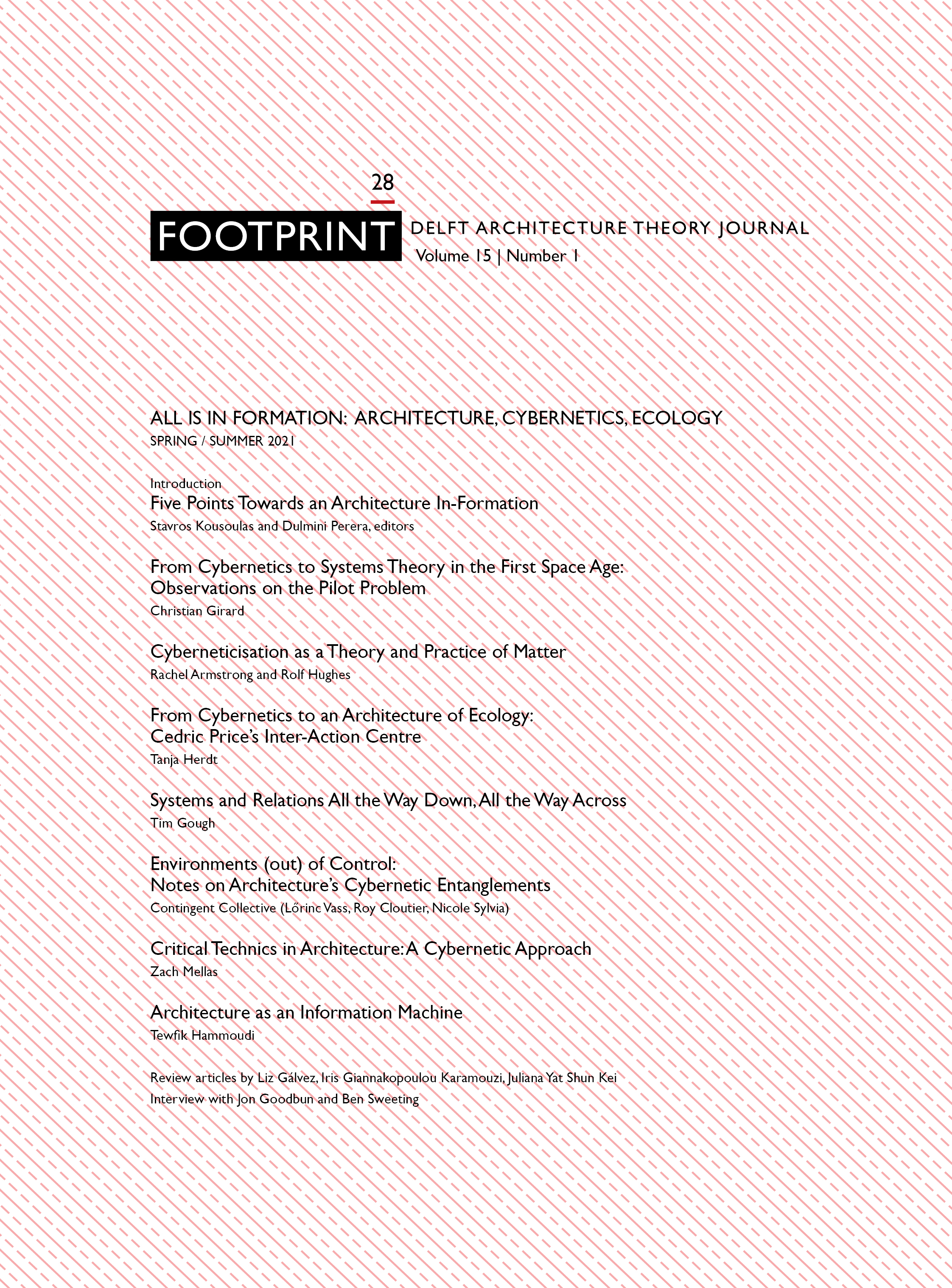The Dialogical, The Ecological and Beyond
DOI:
https://doi.org/10.7480/footprint.15.1.5668Abstract
In this article Jon Goodbun and Ben Sweeting engage in a conversation about design and its complex relation to communication. They look at the role of dialogue, the dialogical (signifying signs), and the limitations of the dialogical as one considers contemporary processes of cybernetisation and how “asignifying signs” are produced and exchanged within complex systems of all kinds. Prompted by the opening question referring to cybernetics as a general study of information processes, focusing on the production, exchange, and consumption of meaning, not limited to a focus on digital logic, Goodbun and Sweeting revisit a plethora of positions on dialogue including those of Gordon Pask, Gregory Bateson, Ranulph Glanville, David Bohm among others. In so doing, they make clear certain semantic confusions related to terms such as communication vs. conversation, dialogue vs. discussion, and analogue vs. digital, and provide a richer understanding of why these semantic revisions are necessary for the context of everyday design practice. Using examples from their own research and teaching work, they point towards models where an alternative approach to communication that critically acknowledges the complications related to “asignifying signs” can help designers grapple with the ecological crisis in the contexts of politics, research, and education.
References
Ashby, W.R. (1956), An Introduction to Cybernetics, London, Chapman & Hall.
Bateson, G. (2002), Mind and Nature: A Necessary Unity, Cresskill, NJ, Hampton Press. Originally published 1979.
Bateson, G. (2000) Steps to An Ecology of Mind. Chicago, University of Chicago. Originally published 1972.
Bateson, G. (1991) A Sacred Unity: Further Steps to An Ecology of Mind, New York, Harper Collins.
Bateson, M.C. (2005), Our Own Metaphor, Cresskill, Hampton Press. Originally published 1972.
Bateson, M. C. (2014). Living in cybernetics: 50th Anniversary conference of the American Society for Cybernetics [Keynote]. Living in cybernetics, Washington, D.C. https://www.youtube.com/watch?v=wpjnVVWXZMs
Bohm, D. (1996), On Dialogue, New York, Routledge.
Extinction Rebellion (2019), Extinction Rebellion People's Assemblies Facilitation Training Manual, https://extinctionrebellion.uk/wp-content/uploads/2019/10/XR-PeoplesManual.pdf
Fantini van Ditmar, D. (2016). IdIOT: Second-order cybernetics in the 'smart' home [Doctoral dissertation, Royal College of Art]. British Library. https://ethos.bl.uk/OrderDetails.do?uin=uk.bl.ethos.690638
Fantini van Ditmar, D. (2019). A circular ‘smart’ world. In T. Fischer & C. M. Herr (Eds.), Design cybernetics: Navigating the new (pp. 101-117). Springer International Publishing. https://doi.org/10.1007/978-3-030-18557-2_5
Fischer, T., & Herr, C. M. (Eds.). (2019). Design Cybernetics: Navigating the new. Springer. https://doi.org/10.1007/978-3-030-18557-2
Glanville, R. (1997). The value of being unmanageable: Variety and creativity in cyberspace. In H. Eichmann, J. Hochgerner, & F. Nahrada (Eds.), “Netzwerke”, proceedings of global village ’97 conference. Falter Verlag.
Glanville, R (1998) A (Cybernetic) Musing: Variety and Creativity, Cybernetics and Human Knowing, 5(3).
Glanville, R. (1999). Researching design and designing research. Design Issues, 15(2), 80-91. https://doi.org/10.2307/1511844
Glanville, R. (2007). Try again. Fail again. Fail better: The cybernetics in design and the design in cybernetics. Kybernetes, 36(9/10), 1173-1206. https://doi.org/10.1108/03684920710827238
Guattari, F. (2008). The Three Ecologies. London, Continuum. First published in France 1989.
Guddemi, P. (2020) Gregory Bateson on Relational Communication: From Octopuses to Nations. Springer Biosemiotics 20. https://doi.org/10.1007/978-3-030-52101-1
Harding, S. (2015). Objectivity for Sciences from Below. In F. Padovani, A. Richardson, & J. Y. Tsou (Eds.), Objectivity in Science: New Perspectives from Science and Technology Studies (pp. 35-55). Springer International Publishing. https://doi.org/10.1007/978-3-319-14349-1_3
Lakoff G. and Johnson M. (1999). Philosophy in the Flesh. NY Basic Books
Pask, G. (1975). Artificial intelligence: A preface and a theory. In N. Negroponte (Ed.), Soft architecture machines (pp. 7-31). MIT Press.
Pask, G. (1980). The limits of togetherness. In S. H. Lavington (Ed.), Information processing (pp. 999-1012). North Holland Publishing Company.
Wiener, N. (1961). Cybernetics: Or, control and communication in the animal and the machine (2nd ed.). MIT Press. (Original work published 1948)
Downloads
Published
Issue
Section
License
Copyright (c) 2021 Jon Goodbun, Ben Sweeting

This work is licensed under a Creative Commons Attribution 4.0 International License.
- Authors retain copyright and grant the journal right of first publication with the work simultaneously licensed under a Creative Commons Attribution License that allows others to share the work with an acknowledgement of the work's authorship and initial publication in this journal.
- Authors are able to enter into separate, additional contractual arrangements for the non-exclusive distribution of the journal's published version of the work (e.g., post it to an institutional repository or publish it in a book), with an acknowledgement of its initial publication in this journal.





